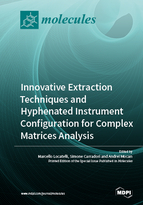Innovative Extraction Techniques and Hyphenated Instrument Configuration for Complex Matrices Analysis
A special issue of Molecules (ISSN 1420-3049). This special issue belongs to the section "Analytical Chemistry".
Deadline for manuscript submissions: closed (31 July 2018) | Viewed by 101705
Special Issue Editors
Interests: innovative (micro)extraction procedures; hyphenated instrument configurations; bioactive compounds; characterization; fingerprints; method validation; HPLC; mass spectrometry; biological matrices; chromatography; analytical chemistry; sample preparation; green analytical methodologies
Special Issues, Collections and Topics in MDPI journals
Interests: chemical modification of natural compounds; medicinal chemistry; food chemistry; antioxidants; antimicrobials
Special Issues, Collections and Topics in MDPI journals
Interests: plant-derived secondary metabolites; antimicrobials; antioxidants; enzyme inhibition
Special Issues, Collections and Topics in MDPI journals
Special Issue Information
Dear Colleagues,
Techniques that can be employed to accelerate extractions, work up, and isolation/purification of the products/metabolites, may be of interest both in the fields of natural products (food, plants, plant-derived products) and in analytical chemistry (biological matrices, clinical trials, sample preparation). In the last few years, the development of innovative procedures has deeply impacted the work of chemists.
The present Special Issue, “Innovative Extraction Techniques and Hyphenated Instrument Configuration for Complex Matrices Analysis”, aims to collect and to disseminate some of the most significant and recent contributions in the interdisciplinary area of innovative extraction procedures from complex matrices followed by validated analytical methods using hyphenated instrument configurations to support the optimization of the whole process and the scale-up possibility.
The scope is broad and includes the use of alternative (green) and/or innovative extraction techniques, optimization of the corresponding parameters by means of experimental design, development of proper solvents (ionic liquids, deep eutectic solvents, cyclodextrins), extract fractioning on the basis of specific biological activities, knowledge of the target structures in order to pursue a targeted analysis, and evaluation of the stability of intermediates/final products.
Accepted paper (both reviews and research papers) could be in the field of: - extraction procedures - hyphenated techniques - food and food supplements analyses - biological analyses - chemometric approaches. Eventually all related to specific biological activities observed.
- Abstract submission February 2018
- Paper submission 31 May 2018
- Revision (Reviewer) end of June 2018
- Revised version end of July 2018
- Final proof first days of September 2018
Prof. Dr. Marcello Locatelli
Prof. Dr. Simone Carradori
Dr. Andrei Mocan
Guest Editors
Manuscript Submission Information
Manuscripts should be submitted online at www.mdpi.com by registering and logging in to this website. Once you are registered, click here to go to the submission form. Manuscripts can be submitted until the deadline. All submissions that pass pre-check are peer-reviewed. Accepted papers will be published continuously in the journal (as soon as accepted) and will be listed together on the special issue website. Research articles, review articles as well as short communications are invited. For planned papers, a title and short abstract (about 100 words) can be sent to the Editorial Office for announcement on this website.
Submitted manuscripts should not have been published previously, nor be under consideration for publication elsewhere (except conference proceedings papers). All manuscripts are thoroughly refereed through a single-blind peer-review process. A guide for authors and other relevant information for submission of manuscripts is available on the Instructions for Authors page. Molecules is an international peer-reviewed open access semimonthly journal published by MDPI.
Please visit the Instructions for Authors page before submitting a manuscript. The Article Processing Charge (APC) for publication in this open access journal is 2700 CHF (Swiss Francs). Submitted papers should be well formatted and use good English. Authors may use MDPI's English editing service prior to publication or during author revisions.
Keywords
- hyphenated techniques
- innovative (micro)extraction procedures
- biological activities
- food and food supplements analyses
- medicinal plants and fungi
- biological analyses
- chemometric approaches









